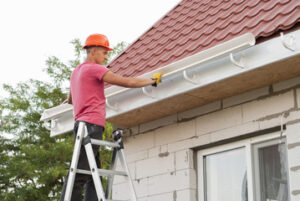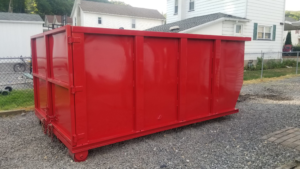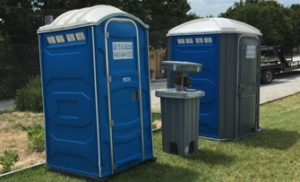Effective gutter systems are crucial for safeguarding homes from structural damage and costly repairs. Professionally installed gutters are properly configured for the region’s average rainfall intensity and weather conditions to ensure proper drainage.

Gutter installation requires meticulous attention to detail to ensure correct sloping and secure fastening, preventing sagging or leaks. Proper drainage is also essential to avoid clogs and water runoff. Contact Gutter Installation Gainesville FL for professional help.
Gutters help keep rainwater away from your home’s foundation, siding, and basement to prevent water damage over time. This is an important DIY task that many homeowners overlook until they notice problems like mold or leaks in their homes. Gutter installation may not be the most fun home improvement project to tackle, but it can save you from expensive and inconvenient future repairs.
This guide will walk you through the steps of the gutter installation process, from planning and measuring to attaching components. It also provides safety precautions and other necessary information, allowing you to complete the project without any hassle or danger.
Before beginning the gutter installation process, make sure that the roof is free of any existing damage. A professional roofer can assess the condition of your gutters and determine if they need to be replaced or repaired.
If you are replacing old gutters, use a tape measure to record the length of the roofline. Then, calculate the total guttering needed to cover this area. Consider the local rainfall intensity and choose a gutter size that will provide adequate capacity and drainage for your home. You should add an extra length to account for corners, downspouts, and end caps.
Downspouts are the pipes that drain your gutter system. They should be positioned at the corners of your house to avoid splashing water around the building and prevent flooding in basements and foundations. They can also be angled to direct water away from the foundation or landscaping of your home, depending on the need.
When installing downspouts, be careful not to make them too steep or they will overflow. A downspout slope of 1/4 inch per 10 feet is ideal for efficient home drainage.
A successful gutter installation will help prevent future issues like mold, foundation problems, and structural damage to your home. Whether you’re replacing your gutters, or installing them for the first time, this guide will take you step-by-step through the process of making sure they are installed properly. It will also help you decide which type of guttering is best for your home.
Measurement
Accurate measurements are vital to a successful gutter installation, ensuring the system fits perfectly and enhances your roof drainage system. This step is also essential for determining the number and placement of downspouts. Downspouts help manage rainwater flow to avoid overflow, which can damage the roof, siding, foundation, and landscaping.
To measure your roofline, use a ladder that extends at least three feet over the edge of the roof and support it securely. Position it on a stable surface and wear non-slip shoes, gloves, safety glasses, and a harness to prevent falls. Ladder work can be dangerous, and over 2,500 workers are injured each year while doing it. Professional gutter installers use aerial measurement tools to reduce the risk of injury and improve efficiency.
Once you’ve measured your roofline, determine how much guttering you need to purchase. Take into account the additional length needed for joints, corners, and downspouts. Then, choose a gutter material that suits your needs and budget. Aluminum is lightweight and rust-resistant, while copper offers a premium look that lasts for decades.
After you’ve determined the size and location of your gutters, calculate their pitch to ensure proper water flow. The ideal gutter pitch is about a quarter inch of slope for every 10 feet.
To determine the correct gutter size, consider your roof’s drainage area, the roof pitch factor, and local rainfall intensity. Oversized gutters can weigh down your roof and cause warping, while undersized ones may not drain properly and lead to overflowing.
To install your gutters, attach them to the fascia board using hangers or brackets. Ensure that they are evenly spaced and have a slight slope toward the downspouts to facilitate water flow. Once the gutters are in place, test them with a garden hose to check for leaks and to see that water exits where it should. After testing, seal any joint seams with waterproof gutter sealant to protect your gutter system from water and weather damage. Finally, add a splash block or extension to the base of the gutters to direct water away from your foundation.
Materials
Gutters help keep water away from the walls and foundations of buildings, preventing water damage. Installing gutters correctly is a key component of home maintenance and repair. To complete a gutter installation, homeowners will need a variety of materials, including gutter sections, downspouts, end caps, and gutter sealant. These components are available in a variety of styles and materials, allowing homeowners to choose the best options for their needs.
Gutter installation requires accurate measurements of the roofline. Measure the length of the entire roofline, and make note of any corners or angles that will need to be bent. This information will be helpful in selecting the proper gutter section sizes. Downspouts are also essential to the gutter system, and should be purchased with the appropriate lengths. Downspouts are designed to drain rainwater away from the foundations of the building, and they should be attached to the wall at least every 6-8 feet. To ensure that the downspouts are secure, they should be fastened to the wall using brackets.
To create a secure connection between gutter sections, end caps and downspouts, use gutter sealant to coat all seams and joints. This will ensure that the gutter system is watertight, preventing leaks and other problems. Gutter sealants are available in a variety of colors, so homeowners can find the perfect option to match their home’s exterior design.
The final step of gutter installation is to connect the downspouts to the gutter sections. To do this, attach the downspouts to the ends of the gutters using brackets. Then, attach the downspout to the gutter, making sure that it follows the slope of the roofline. The downspout should also be firmly attached to the wall, using brackets and screws.
Gutter installation is a simple task for professionals and DIYers who are comfortable working with tools. The basic tools needed for the job include a ladder, measuring tape, hacksaw, drill and hammer, chalk line, and tin snips. In addition to these items, some homeowners may choose to purchase additional tools to streamline the process. These optional tools may include a gutter crimper, which helps to create tight, secure connections between the pieces of gutter. They can also help to improve the speed and accuracy of gutter installation, reducing the amount of time spent on the project.
Installation
Gutter installation may not be a glamorous home improvement task, but it’s vital for water damage prevention. Whether you’re replacing an existing gutter system or installing new ones, proper preparation and meticulous attention to detail ensures a seamless project and a reliable gutter that will protect your property from moisture damage.
To begin, it’s important to familiarize yourself with your local building codes regarding gutter installations, as different areas have unique regulations. This step helps you avoid costly changes and fines down the line. It also helps ensure that your gutters are properly installed to perform optimally for your area’s climate conditions.
Next, carefully measure your roofline and determine the number and placement of downspouts. This allows you to purchase the appropriate amount of materials, preventing waste and saving money. It also helps ensure that your gutters have an appropriate slope to facilitate water flow and prevent overflow during heavy rain.
Once you’ve gathered your tools and materials, you can begin the actual installation process. Begin by attaching fascia brackets evenly along the eaves, then installing gutter sections and downspout outlets to these brackets. To ensure a secure fit and a smooth appearance, apply silicone caulk to all seams. Finally, connect the downspouts and test your gutter system by running a garden hose over it to check for leaks and proper flow.
A gutter system can last an average of 20 years, but proper maintenance and regular testing help extend its life. It’s crucial to keep your gutters clean of leaves, twigs, and other debris that can clog them. Schedule frequent cleanings, especially in the fall and spring when debris accumulation is highest. Regular testing and inspections help identify any issues before they become major problems.
A reputable gutter installation company is well-versed in the latest roofing and drainage technologies to ensure the highest quality results. In addition to accurate measurements and careful installation, they’ll also consider your home’s aesthetics to ensure that your gutter system blends seamlessly with your home. They can also provide recommendations on gutter material and style to suit your unique needs.








